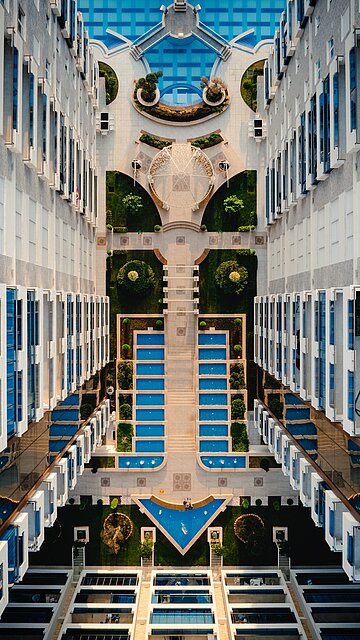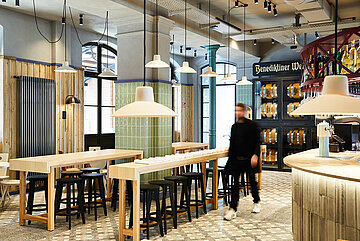Hardly anything poses greater challenges for the out-of-home market than the pandemic and climate change. What effects does this have on hospitality architecture and what trends will shape tomorrow? We look at the hotel and gastronomy sector:
Sustainability in focus
Sustainable, individual, and expressive architecture is considered one of the most important trends in hotel and hospitality architecture this year. Hoteliers are paying attention to environmentally friendly construction methods and healthy materials for new buildings and extensions. Wood, stone, or glass play a decisive role.
In the case of buildings with a good historical structure, an attempt is made to restore them to their origins and to add new things in such a way that they follow the original logic and create an atmosphere that invites people to linger as well as pause.
The subject of planting is no longer a shadowy existence: whether indoors or as part of the overall architectural concept - in the future, the motto will be "the greener, the better". After all, plants do not only contribute efficiently to CO2 reduction, but also create a distinctive design and a feel-good atmosphere that guests appreciate.
Similar characteristics can be seen in interior design of restaurants. Sustainable materials are essential basics of interior concepts. For example, the Benediktiner Weissbraeuhaus in Giessen, Hesse, focuses on naturalness, combining tradition and modernity by not overloading the individual rooms, but rather relying on a minimalist, simple room concept. This shows: Sustainability and smart design are by no means opposites.
Regionality as an important factor
At the same time, the regional reference of materials is making an increasingly important contribution. For example, the Biorefugium Theiner's Garten in South Tyrol was built according to strict building-biology guidelines in Holzius solid wood construction and uses wood only from sustainably managed forests in the region. This coincides with furnishing concepts of modern restaurants. Materials from other countries that have nothing to do with the place, culture, tradition, and craftsmanship are avoided. Instead, the focus is on materials that live, that touch and want to be touched.
Breaking down barriers - space for all
For many of the approximately eleven million people with disabilities in Germany, traveling presents major challenges. People who rely on wheelchairs encounter considerable barriers. e.g., in booking of accommodations. This issue has been taken on board by planners. Today, hotels and restaurants are designed to be barrier-free. This is about more than just easy access to the restaurant, hotel or barrier-free sanitary facilities. Accessibility means inclusion, openness and expresses a stylish and welcoming atmosphere for all visitors. The first inclusion hotels have already opened, for example the Hotel Includio in Regensburg, Bavaria. Others will follow the positive examples.
Outdoor first
Space to breathe: The desire for fresh air has increased due to the pandemic. Many people perceive indoor spaces as oppressive and prefer outdoor meeting places. No wonder that resort hotels in particular, which architecturally address the need for open space, are enjoying increasing popularity.
However, the integration of outdoor areas in urban environments is also becoming increasingly important. Roof terraces or cosy outdoor lounges in hotels and restaurants offer a welcome outdoor retreat. With the right concept, these are also popular outside the classic open-air season.


